Community Law Enforcement
Sheriff race bias in Lancaster?
August 6, 2010
 A special counsel to the Board of Supervisors has raised serious concerns about whether blacks in Lancaster are being arrested far too often by sheriff’s deputies for so-called “contempt of cop” violations.
A special counsel to the Board of Supervisors has raised serious concerns about whether blacks in Lancaster are being arrested far too often by sheriff’s deputies for so-called “contempt of cop” violations.
In a report released Friday, Special Counsel Merrick Bobb said he and his investigators “were troubled by a seemingly overzealous use of such charges against blacks in the Lancaster area.” He said arrest patterns in Palmdale and Carson raised some of these same concerns, “but to a lesser degree.”
The findings are contained in Bobb’s 29th semi-annual report on the Los Angeles County Sheriff’s Department. This one focuses largely on potential racial disparities in arrests during 2007 in which suspects were accused solely of crimes against police officers. Broadly called “obstruction,” these include resisting arrest, delaying or obstructing a peace officer and battery on a police officer without injury.
Bobb said that high numbers of these kinds of arrests involving specific racial groups are a warning sign of possible systemic discrimination by police.
Although Bobb said he found “significantly disproportionate” numbers of obstruction arrests by Sheriff’s deputies assigned to the Lancaster station, that was not the case in Los Angeles County overall, despite the fact that blacks are being arrested in numbers that far surpass their representation in the population.
In coming to that conclusion, Bobb compared the proportion of obstruction arrests to the number of total arrests for blacks, Latinos and whites. Among the three, he found the proportions to be roughly similar.
“Our findings do not demonstrate that there is a greater burden on blacks in general in the county [for obstruction],” Bobb said. “Even though the general criminal justice system in Los Angeles falls more heavily on blacks.”
Bobb said there were, however, significant differences among the races in whether those obstruction arrests were filed as felonies or misdemeanors, with Latinos and blacks facing the more severe charges far more often.
Bobb offered no firm explanation for what he called the troubling racial disparities in Lancaster, located 55 miles northeast of Los Angeles. There, blacks, who represent only 17% of the population, comprise 42% of all arrests. They account for 64% of the obstruction arrests—a disparity far larger than anywhere else the Sheriff’s Department patrols in L.A. County.
 In an interview, Bobb said the sheriff’s top commander in the Antelope Valley region, Chief Neal Tyler, told him that residents expect the department’s nearly 200 sworn personnel to police aggressively.
In an interview, Bobb said the sheriff’s top commander in the Antelope Valley region, Chief Neal Tyler, told him that residents expect the department’s nearly 200 sworn personnel to police aggressively.
“He noted that those communities ask for and demand a level of [patrol] activity that may result in more confrontations and stops,” Bobb said, adding that Tyler agreed that the issue “merits further inquiry.”
Sheriff’s spokesman Steve Whitmore said the department was pleased with Bobb’s countywide findings and will examine closely the potential problem areas cited in the report.
“Yes, L.A. County can do better and we will always strive to improve,” Whitmore said, acknowledging that the department polices aggressively in the high desert cities of Lancaster and Palmdale “to keep the streets safe and secure. It’s an aggressive area.”
As part of his latest report, Bobb also examined hate crimes and the department’s investigation of them.
Bobb praised the department’s Hate Crimes Task Force, calling it “a model of its kind.” Between 2007-09, the two-detective unit investigated more than 200 hate incidents and crimes, nearly half of the county’s cases. The unit has been widely praised in the gay and religious communities, Bobb said in an interview.
In contrast, Bobb found that the quality of hate crime investigations conducted at five randomly selected sheriff’s stations “varies considerably, from poor to acceptable to very good at the West Hollywood Station.”
He was harsher when it came to the department’s treatment of hate crimes inside the county’s jails.
“Investigation of hate crimes in the jails is shameful and reflective of an unwillingness or inability to recognize hate crimes as such,” Bobb said in his report.
Among other things, he said that potential hate crimes are not thoroughly investigated.
The report cited a 2009 case in which a disabled white man was beaten for two days by at least three inmates before jailers came to his aid, the report said. He was choked, punched and beaten with one of the inmate’s prosthetic leg.
Bobb said evidence suggested he might have been beaten because he was white, disabled or for both reasons. The assailants allegedly called him a “blue eyed devil” during one of the beatings. A deputy later noted in a report that “I believe the primary motivation for the [assault] was due to [the victim’s] disability.”
Bobb said he found it “shocking” that the investigating detective appears to have “simply abandoned the case…despite known suspects and much testimony on record.” Bobb said investigators seemingly “let the case fall through the cracks.”
For the special counsel’s complete report, including recommendations, click here.
Posted 8/6/10
L.A. Coroner gets some hi-tech help
July 14, 2010
It’s a “CSI” world out there. But when it comes to in-house DNA testing, the L.A. County coroner’s office might as well be back in the “Quincy” era.
That’s about to change. Armed with start-up funding from the county’s Quality and Productivity Commission, the department is embarking on a plan to create its own small DNA lab. The department will hire expert consultants who will help it establish an accredited lab that can help coroner’s officials solve some of their toughest cases—and perhaps even turn a profit.
The proposal for the lab, which will be funded for three years with $1.6 million annually from the commission’s Productivity Investment Fund, was approved by Los Angeles County Supervisors on Tuesday.
Anthony T. Hernandez, director of the coroner’s department, said establishment of the lab is “way overdue.” New York City’s Office of Chief Medical Examiner has the largest coroner’s DNA lab in the country, and has been performing such testing since 1991.
In L.A. County, a primary function of the new lab will be to shortcut the often time-consuming—and sometimes futile—work of identifying the 350 to 400 John and Jane Does who come through the coroner’s office annually. There are at least 25 such “hardcore” cases that elude investigators each year, Hernandez said.
Having a DNA lab also will allow coroner’s officials to take on the 100 or so paternity requests it receives each year. These often come from people trying to claim Social Security or other benefits for children of people who have died. As it stands now, their requests must be farmed out to private DNA analysis firms.
Others turn to the coroner’s office seeking paternity information that will help them come to terms with mysteries that have haunted them all their lives.
“It does fill an emotional void for a lot of folks,” Hernandez said.
Once the lab is up and running, the coroner’s office says it also will be able to assist law enforcement agencies struggling with a backlog of cases, including large numbers of untested sexual assault kits that have plagued agencies such as the Los Angeles Sheriff’s Department.
“We don’t profess to make a giant dent in that, but we think we could help,” Hernandez said.
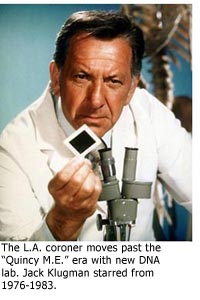 Dr. Lakshmanan Sathyavagiswaran, the county’s Chief Medical Examiner/Coroner, said he’s excited about the possibilities of the new lab from an investigative standpoint.
Dr. Lakshmanan Sathyavagiswaran, the county’s Chief Medical Examiner/Coroner, said he’s excited about the possibilities of the new lab from an investigative standpoint.
“I’m all for it,” Sathyavagiswaran said. “We’ll be a full-service department.”
Sathyavagiswaran, in an interview outside the Board of Supervisors hearing room, said the new lab will be helpful in “subtle cases where it’ll enhance the quality of death investigation.” Those cases include deaths by Long QT Syndrome, in which the heart stops for no obvious reason, such as in an apparently healthy high school athlete. DNA testing also could be useful in uncovering hidden crimes in cases where the cause of death was obvious–for example, a woman who’d died of a heroin overdose but also may have been the victim of a rape before her body was dumped.
“The citizens of L.A. will benefit from this DNA laboratory,” Sathyavagiswaran said in a follow-up email.
With 18,000 deaths reported to the L.A. County coroner’s office each year, it ranks as one of the world’s busiest, with responsibility for investigating thousands of violent or unusual deaths each year, along with notifying next of kin and determining how and why deaths occurred.
Dr. Jeffrey Jentzen, a chair of the National Association of Medical Examiners’ committee on inspections and accreditation, said it makes sense for L.A. to join other major jurisdictions like New York and Houston in having an in-house coroner’s DNA lab.
“The quicker you can make identifications, the better you can keep the flow of bodies moving and avoid backups,” Jentzen said.
There are also financial incentives, according to Hernandez. He said the lab is expected to generate revenue from paternity testing and from collecting fees from law enforcement agencies and smaller coroner’s offices seeking help with their cases.
“We have been working on the implementation of DNA testing since late 2006,” Hernandez said. One reason it took so long is that the department tried to find a way to establish the new lab “in a way that doesn’t cost the county anything.”
The seed money from the productivity commission fund, he said, will enable the department lab to start small and grow into a self-supporting and eventually profitable endeavor.
It also could help the department keep up with the expectations of the television-watching public. Said Hernandez: “You’d be surprised how many folks do think ‘It’s the coroner. It’s just like CSI.’ “
Posted 7/14/10
New turf for the sheriff’s watchdog
July 7, 2010
Veteran civil rights lawyer Michael Gennaco has focused for nearly a decade on one job: keeping an eye on the Los Angeles Sheriff’s Department.
As chief attorney of the respected Office of Independent Review, Gennaco has built a model oversight unit, investigating everything from on-duty shootings to off-duty drunkenness. Although not beloved by the rank-and-file, the unit has the support of Sheriff Lee Baca and has been credited with improving the department’s training and discipline.
Now Gennaco finds himself on a new mission, one that has put him and his team front-and-center in one of Los Angeles County’s most vexing and embarrassing controversies. The Office of Independent Review, or OIR, has been recruited by the Board of Supervisors to help restore accountability and integrity to another one of the county’s criminal justice agencies—the scandal-plagued Probation Department.
It’s a new challenge—“a whole new world,” Gennaco says—but also the natural extension of his work monitoring the Sheriff’s Department and his earlier career as a widely praised federal prosecutor specializing in law enforcement misconduct and civil rights violations.
“I have a world vision in which police officers obey the law, a vision that is supported in most cases,” Gennaco says. “But there are times when they abuse their power. The victims of police misconduct don’t have power and authority and the ability to get redress. They’re not the people in Malibu.”
The mandate
In the weeks ahead, Gennaco’s team of six lawyers will be expanded to eight. He’ll send a pair of them to the Probation Department with orders to improve the speed, quality and effectiveness of internal discipline. The OIR lawyers will work hand-in-hand with the agency’s new chief, Donald Blevins, who has vowed to crack down on misbehavior and rebuild the department’s management ranks.
Although the details of the arrangement are still being worked out, Gennaco says he believes that “the expertise we have from the Sheriff’s Department will transfer over effectively.” And, the supervisors hope, quickly.
In recent weeks, the reputation of the 6,000-person department has come under withering assault amid disclosures of institutional failings and individual misconduct.
Staffers have been accused of, among other things, using department credit cards to buy electronic goods and of allowing juvenile charges to engage in video-taped brawls in probation camp classrooms. The department’s managers, meanwhile, have drawn the ire of the Board of Supervisors for being unable to fully account for $79 million that had been allocated to comply with federal mandates to improve conditions in the department’s network of juvenile camps and halls.
As county Chief Executive Officer William T Fujioka put it at a recent board meeting: “The depth of the problems in this department are shocking.”
By then, Gennaco and his team of OIR lawyers had thrown their own fuel on the fire. In a report requested by the supervisors and released last month, OIR disclosed that breakdowns in the Probation Department’s internal affairs operation had allowed dozens of employees accused of misconduct—some of it serious—to escape discipline because the investigations ran too long.
The 60-page report concluded by calling for “the establishment of a permanent independent oversight group”—a job that would promptly be added to OIR’s portfolio.
Gennaco says he’s optimistic change will come. He says the department offered “no resistance” while his team spent three months assessing the internal affairs operation and that the agency’s brass already has adopted some of his team’s 34 recommendations.
Asked whether the rank-and-file might resist his efforts, given the insular nature of law enforcement agencies, Gennaco said simply: “I don’t know.” But he added that swift, accurate investigations are in everyone’s interest, including employees who could be exonerated of wrongdoing.
On a personal level, Gennaco says, he’s “more energized than worried” about the high expectations that have been placed on him because he’s a true believer in the mission that’s been entrusted to him.
Righting wrongs
Raised in a multi-ethnic household, the son of an Italian-American dad and a Latina mom, Gennaco says his interest in civil rights started young. Two of his early heroes were Robert F. Kennedy and Thurgood Marshall. After graduating from Dartmouth College, he attended Stanford University law school and clerked for U.S. Circuit Judge Thomas Tang, the first Chinese-American on the federal bench.
In 1984, Tang encouraged an uncertain Gennaco to join the Department of Justice’s Civil Rights Division, despite concerns that the unit’s work ranked low on the Reagan agenda. “Judge Tang told me if there’s any time when they need good people, it’s now,” Gennaco recalls.
From his post in Washington, Gennaco prosecuted civil rights cases across 20 states, particularly in the South, and began to hone his skills on police misconduct cases. One of those cases gave him his first taste of police culture in Los Angeles when, in 1992, he successfully prosecuted a white LAPD officer assigned to the San Fernando Valley who beat a Latino teenager so severely with a baton that he sustained permanent brain injuries.
In 1994, Gennaco joined the United States Attorney’s Office in Los Angeles, where he established its first civil-rights unit and was credited with expanding the number of investigations and prosecutions of police misconduct and hate crimes. Among his most high profile cases was the prosecution of neo-Nazi Buford O. Furrow Jr., who opened fire at a Jewish day care center in the San Fernando Valley, wounding five. Furrow later shot and killed a Filipino postman.
In 2001, with the LAPD embroiled in a scandal over rogue cops selling drugs and covering up unprovoked shootings, Sheriff Baca surprised the national law enforcement community by calling for the creation of a civilian oversight unit that the sheriff hoped would provide credibility to the department’s internal investigations.
For Gennaco, the timing was perfect. After 16 years of prosecuting individual cops, he was frustrated. He had come to believe that law enforcement agencies effectively bred large-scale misconduct by failing to stamp out small-scale misbehavior early.
“When this [OIR] opportunity popped up, I thought ‘Here’s a chance’” to attack the root of the problem at one of the nation’s largest law enforcement agencies. Gennaco applied for the job and was unanimously picked by the Board of Supervisors, he says, from among 200 candidates.
Since then, Gennaco has earned a reputation as a steady and determined steward of OIR. The unit has produced dozens of reports across a wide array of issues that focus not only on the conduct of individual deputies but also on the practices and policies of the institution itself.
One, for example, led to changes in weapons training after OIR examined a high number of shootings in which deputies were firing multiple rounds. Another, more recently, led to changes in hiring standards, which OIR concluded had been loosened in a rush to increase the department’s ranks and that had resulted in the hiring of recruits with questionable backgrounds. Yet another OIR effort helped create better training for deputies assigned to the jails so they could reduce the number of suicides and homicides among inmates.
Asked for OIR’s biggest success, however, Gennaco had one word—transparency.
“Before we got here, the public had almost no information coming from the department about what kind of conduct was being alleged,” says Gennaco, who lives in Hermosa Beach with his wife of 18 months.
“There are people [in the Sheriff’s Department] who chafe a little whenever we come out with a report,” he says. “But we have to be critical of the department when we have reasons…We have a responsibility to shine a light and that’s uncomfortable.”
Perhaps the most important lesson he’s learned over the years is that civilian oversight, to be effective, must be sustained over time.
“It’s not as if you can fix the department and just go away,” he says—a conviction the Probation Department is about to experience up close.
Posted 7/7/2010
Taking a shot at pot in L.A. County [updated]
July 6, 2010
 Supervisors rolled out the unwelcome mat for medical marijuana dispensaries Tuesday, voting to draft a ban on such establishments in unincorporated areas of Los Angeles County.
Supervisors rolled out the unwelcome mat for medical marijuana dispensaries Tuesday, voting to draft a ban on such establishments in unincorporated areas of Los Angeles County.
The board, acting on a motion by Supervisor Michael D. Antonovich, instructed the county’s Regional Planning Department and the County Counsel to come up with an outright ban that would replace the 2006 ordinance that had regulated the dispensaries with a restrictive conditional use permit process. Before taking effect, the ban must go to the Regional Planning Commission, which will hear public testimony prior to a formal hearing before the Board of Supervisors.
Under the county’s existing ordinance, no medical marijuana outlet has been approved in county territory, prompting Supervisor Zev Yaroslavsky to wonder aloud about the need for a new law. “I’m just trying to understand if this is a motion in search of a problem,” Yaroslavsky said.
Medical marijuana dispensaries, which have generated long-running public debate particularly in the city of Los Angeles, have received heightened attention in recent days after a series of shootings at dispensaries in Echo Park, Hollywood and Northridge.
At the same time, the city has scrambled to rein in hundreds of dispensaries after the City Council in January approved an ordinance to regulate such establishments and force many out of business. Some, however, have vowed to remain open, and a legal challenge to the city ordinance is underway.
People on both sides of the issue spoke before the supervisors’ vote. Supporters of the ban expressed concern that regulations against the dispensaries in Los Angeles and other cities would push the medical marijuana sellers into unincorporated areas.
Jacquelyn Lacey, speaking on behalf of District Attorney Steve Cooley, who supports the ban, said the crackdown would send operators into “friendly territory” in unincorporated areas of the county.
Another ban supporter, attorney Tulane M. Peterson, added: “This is a public safety issue. It is not a debate over the medical properties of a drug.”
But others, like Barry Kramer, a medicinal marijuana patient, said the county shouldn’t discard a “very good working ordinance.” “You just need to enforce that ordinance to keep out medical marijuana dispensaries that should not be opened,” Kramer told the supervisors. “It’s a mistake that the city of Los Angeles made. They never enforced the moratorium that they put in place. And by not enforcing it, they allowed for that proliferation.”
Planning officials said five applicants have formally tried to open legal medical marijuana dispensaries in unincorporated Los Angeles County since 2006. One application was denied, another was withdrawn and three are currently pending, in Monrovia, Covina and East Los Angeles. The Monrovia project, proposed by the owner of a self-serve car wash, has drawn widespread outrage in that community.
The county’s 2006 ordinance gives planning officials leeway to keep marijuana dispensaries away from sensitive areas such as daycare centers and to make sure they are not “detrimental to the surrounding area,” said Mark Child, head of the planning department’s permit section.
Before the vote, Yaroslavsky said the focus should be on illegally-operating dispensaries, which he said cause most of the problems. As an amendment to the motion that eventually was unanimously approved by the board, Yaroslavsky asked that county planners report back with some ideas on shutting down illegal outlets that could be incorporated into the new ordinance. And board chair Gloria Molina directed county planners and attorneys to find ways to move against rogue operators more quickly.
Since 2006, 27 marijuana dispensaries have been caught operating illegally in unincorporated L.A. County. Eighteen stopped when they received a notice from enforcement authorities, five currently are being investigated and four required civil court action, with one case still pending in appeals court.
An amendment from Supervisor Mark Ridley-Thomas sought to insulate the county from a possible legal challenge to the new ban. Under his amendment, which was adopted as part of the board vote, the ordinance would revert to the current law if the California Supreme Court or Court of Appeals ruled against outright bans.
An appellate ruling is expected soon in a case that could have implications for the new L.A. County measure. A group called the Qualified Patients Organization has challenged the city of Anaheim’s 2007 ordinance barring the dispensaries, saying that it flies in the face of the state’s medical marijuana law. A trial judge backed the city, and the matter is now before an appeals court.
Another potential complication could arise with this November’s vote on whether to legalize marijuana in California. Dr. Jonathan E. Fielding, L.A. County’s top health officer, recently developed an analysis of medical and recreational marijuana for supervisors in advance of that vote.
Posted 7/6/10
Updated 11/23: As expected, the Board of Supervisors on Tuesday voted in favor of an ordinance that would ban all medical marijuana dispensaries in unincorporated county territory. Led by Supervisor Michael D. Antonovich, the move was taken, in part, because of concerns that crackdowns in neighboring jurisdictions would potentially boost the number of operators flowing into unincorporated county areas.
The ordinance, recommended by the Regional Planning Commission, was approved 4-1, with Supervisor Yaroslavsky dissenting. Yaroslavsky argued that the measure not only undermined California’s voter-approved Compassionate Use Act but was also unnecessary.
Yaroslavsky said that, because of the county’s rigorous permitting process, no dispensaries had legally opened in unincorporated areas. The problems with dispensaries, he said, have been limited to a number of “bad actors” who’ve skirted the process and who’ve not been shut down quickly enough.
To correct that situation, the board unanimously approved a motion by Yaroslavsky that would, among other things, direct county enforcement teams “to utilize the toughest available enforcement mechanisms against illegal operators, including imposing fines of up to $1,000 per day against the operators and/or landlords of illegal marijuana dispensaries.”
Young probationers get lessons for life
May 5, 2010
When DeMarco Miller left L.A. County jail last fall at the age of 18 with a felony burglary conviction, his chances for rehabilitation didn’t look good.
The South L.A. youth was a member of the Crips. He faced three years’ probation for stealing a student’s cell phone. He hadn’t finished high school and he’d never held a job. Monthly meetings with his probation officer were cursory and unproductive.
But since January, Miller, now 19, has begun to turn his life around thanks to an innovative pilot program that provides high-risk young probationers with concentrated doses of skills training, behavior modification classes and job preparation.
On Friday, Miller will be one of 36 young adult probationers graduating from the Adult Day Reporting Center, housed in a one-time furniture factory on south San Pedro Street. So far, 79 young probationers have graduated from the program since its inception in late 2008.
The other day, Miller and some of his fellow probationers gathered for a graduation-preparation session, where they struggled with one small but telling symbol of the new direction of their lives—a necktie. “Where does this part go?” Miller asked sheepishly, holding up the broad end of a green tie, which was provided by probation officials, who are also lining up graduation suits.
The former gang member says that, only months ago, he would never have envisioned himself getting all dressed up with someplace truly important to go. Miller credits the program with giving him a sense of his potential.
“I’m glad I got sent here,” says Miller, who started in January and now hopes to be placed in a job in construction. “I didn’t like it at first, but then I’d go home with a happy attitude every day. I learned to be more mature. You’ve got to work before you can eat.”
The premise of the program is that young at-risk probationers can avoid future trouble¬—and hard time in prison—if they learn social and behavioral skills that life on the streets failed to teach them. Six probation officers lead classes in motivation, teaching social skills, moral reasoning and anger management. Incoming probationers are assessed for their educational, substance abuse and mental health needs. Students, who come three to five days a week, move at their own pace, taking six to nine months to finish the program.
“A lot of our clients are guys with state prison hanging over their heads,” says Edward Sykes, a supervising deputy probation officer who runs the center’s day-to-day operations. “If we can get these guys to change the way they think, they can begin to move away from gang membership and crime on their own.”
Probation officials say they’re not discouraged by the fact that the graduation rate remains low and that participation can be spotty. Of the 230 who have been enrolled, more than 25% never showed up for classes or left because of new arrests. Probation officials say they are so committed to the program that they’ll find additional funding when a $5 million state grant expires in August—even if they have to cut parts of the program.
“We’re committed to keeping it operational,” says Cal Remington, the department’s acting chief deputy probation officer. Come 2011, new state funding will arrive, with plans by the department to expand the pilot program.
Probationers are involuntarily assigned to the program by judges or probation officers after felony convictions for crimes ranging from assault and robbery to burglary and drug sales. Sex offenders and probationers convicted of gun-related crimes are barred. About half are gang members. Probation officers proudly note that the San Pedro Street center has been free from gang fighting.
The prospect of employment is the program’s biggest carrot. Graduates have been placed in building maintenance, hotel hospitality, food service, carpentry and other construction work. Some even have become ushers for Cirque de Soleil, says Erick Cerda, the program’s employment resource coordinator. On Fridays, visitors from various workplaces meet with groups of probations to share their job experiences.
Probation officers assigned to the Adult Day Reporting Center are given a lower caseload, meaning they can develop deeper relationships with their charges, many of whom, like Jesus Escobar, appreciate the extra support.
Escobar was a tagger convicted in 2008 of defacing Metro buses with his “SHOTS” signature. Before he was assigned to the program, he says, his first probation officer was too jammed to spend time. “It was ‘hi’ and ‘bye’,” Escobar, now 22, recalls.
But Escobar was determined to finish high school and enroll at the University of Southern California, which he knew mainly from riding bikes nearby as a kid. When he was assigned to the Day Reporting Center, he got the push he needed.
His new probation officer, Gabriel Perez, encouraged Escobar to take community college classes and apply to USC last year. A day before Escobar’s graduation from the probation program in May, 2009, he learned that he’d be a Trojan.
Escobar is now a sophomore, studying sociology and political science and aiming to become an attorney. He says he “still feels a little weird” on campus and is shy about reaching out because of his background. He suspects there aren’t many students like him who arrive at school every day on public transportation from Watts.
“None of this would have happened for me if it hadn’t been for this probation program,” Escobar says while strolling with a visitor on the USC campus. “They believed in me.”
Posted 5/5/10
New probation chief vows reform and innovation
April 15, 2010
Donald Blevins, Los Angeles County’s newly named probation chief, is under no illusions. He knows that, beginning Monday, he’s taking control of a seriously troubled organization, one that’s been under fire for everything from bad budgeting to allegedly abusive behavior towards its juvenile charges.
“My assessment is that it’s a department that’s been good at saying what they are going to do and terrible at following through,” he says, adding that this lack of accountability “is going to stop here in a hurry.”
In the past, Blevins says, “the department hasn’t had strong enough leadership from the top on down.” He says he aims to fix that by moving managers out of areas that are failing. And if that doesn’t work, he says he’ll do what he did in his last job as the head of Alameda County’s probation department.
“I encouraged a few people to retire,” he says.
In Los Angeles, the job is likely to be a lot tougher, simply given the size of the Probation Department, the nation’s largest, with 58,000 adults and about 20,000 juveniles in the system. The department has a workforce of 6,100 employees and a budget of $693 million.
In recent years, most of the criticism leveled at the department has involved its operation of juvenile halls and camps.
The U.S. Justice Department in 2008 concluded that the Probation Department had failed to provide adequate mental health for juveniles in its custody and to report and investigate allegations of abuse—situations probation officials are working to correct. The American Civil Liberties Union, meanwhile, alleged in a suit earlier this year that educational programs at Camp Challenger in Lancaster were so inadequate that functionally illiterate juveniles were being given high-school degrees.
More recently, the Probation Department’s interim chief, Cal Remington, disclosed that internal affairs had a backlog of over 150 unfinished misconduct investigations. Blevins, who praised Remington’s brief stewardship of the department, said he has agreed to stay as Blevins’ No. 2 for at least a month.
In a get-to-know-you meeting last week with managers, Blevins said he had “zero tolerance” for abuse and warned that staff members who mistreat those in custody will be fired or punished. He hopes better training might help the staff find ways to defuse tense situations before they turn violent.
Blevins, 58, was hired because he was seen not only as a tough manager but as someone with creative solutions to difficult problems, a reputation he says comes from having “literally worked every job there is” in a probation career spanning 35 years.
In nearly seven years as Alameda’s probation chief, Blevins helped transform the $96 million department with a staff of 650 in an era of tight budgets. He oversaw construction of a state-of-the-art juvenile hall, created “evidence-based” programs, improved psychological and medical services and launched innovative transitional programs to help juvenile offenders successfully return to home and school.
“I think he’s a person who showed great leadership,” says Alameda County Board of Supervisors President Alice Lai-Bitker. “He was very collaborative in working with the other departments to improve services.”
Added Carol Biondi, an influential member of the L.A. County Commission for Families and Children: “I hope he is as forward thinking here as he was in Alameda.”
Blevins, who’ll be confronted with a budget deficit estimated at about $50 million, vows to hit the ground running, immediately working to clear the backlog of internal affairs cases and pressing county education officials to add more permanent teachers to the programs they run for juveniles.
“My goal is to make sure that this department becomes a leader and not a follower in innovative practices,” Blevins says. “We need to become the most innovative department in the state of California.”
Blevins, who is still unpacking boxes at a new house in Huntington Beach with his wife, Laura, appears unfazed by the challenges that have bedeviled his predecessors.
“I look at it as the opportunity of a lifetime to be able to run a department this size,” he says. “I think I’m ready for the challenge, and I think I’ll do a good job.”
A key man for a new gang plan [updated]
March 25, 2010
Pacoima is about to see a lot of Greg McCovey.
In this east San Fernando Valley neighborhood, the veteran probation official will soon become the point man for L.A. County’s long-awaited and multi-faceted anti-gang initiative, which the Board of Supervisors is scheduled to review on Tuesday.
Pacoima is one of four gang hotspots that, under the initiative, would be a testing ground for a new approach by the county, placing a much heavier emphasis on gang prevention, in addition to suppression. The other areas, spread across the county, are: Harbor Gateway, Monrovia/ Duarte and Florence/Firestone, home to one of the region’s most entrenched gangs, Florencia 13.
The $3-million plan—several years in the making—calls for a collaborative and coordinated effort among multiple county agencies to ensure that services are directed at juveniles who’ve been accused of gang membership and identified as high-risk for re-joining a gang. The services, which are designed to parallel stepped up law enforcement, also would be provided to families of these individuals.
The Chief Executive Office (CEO) is recommending to the board that, in each of the four targeted areas, the initiative would begin by focusing on 25 juvenile probationers whom the county will attempt to steer from the gang life by bolstering mental health, welfare and economic services. Overseeing each of those four areas will be a “site coordinator” directing several “work groups” responsible for specific facets of the strategy, including providing more parks and library services aimed at the larger community.
McCovey is the first—and, so far, the only—site coordinator selected.
A 20-year Probation Department veteran, he’s anxious to get to work. “This is a great opportunity to bring together a broad array of services to help the community and our (gang) families,” McCovey says. “It’s exciting.”
McCovey, 50, has a good resume for understanding and combating gang culture. In his last assignment in the Probation Department, he directed the intake decisions about where to send minors in juvenile halls throughout the county. Before that job, McCovey directed the Probation Department’s post-release programs from juvenile camps, so he’s seen what happens when gang probationers re-enter the community.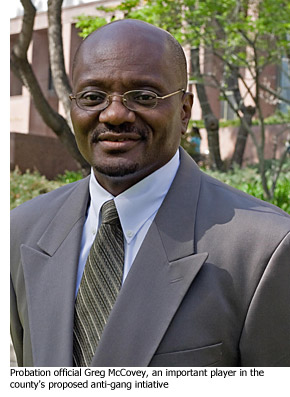
For the past year, McCovey has been on loan to the CEO’s office to help refine the county’s gang plan. He spent time exploring all four neighborhoods in the pilot project, meeting with residents and community groups. And within the next few weeks, he’ll begin interviewing the families of Pacoima probationers to determine which 25 juveniles are at high risk for returning to gangs unless they—and their families—get help.
Pacoima is unique among the four areas because it falls entirely within the City of Los Angeles, McCovey says. That will make some aspects of his job easier because the city already has instituted its gang prevention and patrol initiatives, which are serving as models for the county.
McCovey will work closely, for example, with Los Angeles’ Gang Reduction Youth Development program, the city’s own prevention effort, launched in 2007. The city’s Summer Night Lights program of nighttime soccer, basketball and cultural programs already is in place in Pacoima. The county plans to export similar programs to county parks in the other three demonstration areas.
McCovey says his greatest challenge may be to ensure that county agencies involved in the proposed anti-gang initiative can quickly bring their unique assets to the gang problem without duplicating efforts.
“There are a lot of different groups out there doing good work,” McCovey says, “and we don’t want to overlap.”
If the Board of Supervisors gives a green light to the latest phase of the plan, McCovey expects to start full-time early next month. When not on the ground in Pacoima, he’ll be based in the CEO’s office downtown with the other soon-to-be-selected coordinators.
“I’m very aware of the barriers that kids face when they return home,” McCovey says. “What I want to do is break down those barriers to ensure they have every opportunity to succeed.”
Posted 3/25/10
Updated 4/6 /2010:
The Board of Supervisors unanimously approved the latest phase of the county’s long-anticipated gang reduction initiative after it was amended to modify personnel plans and costs. Among other things, the plan establishes pilot programs to better coordinate anti-gang strategies in four key neighborhoods plagued with gang issues.
Most of the changes Tuesday involved the four “site coordinators” of the pilot programs who would oversee the program in their areas and direct the delivery of services by county departments and local gang prevention groups.
Under the original plan, the coordinators potentially could be hired from several county departments playing key roles in the anti-gang initiative. The plan also included $871,000 for departments to “backfill” for individuals selected as site coordinators.
But an amendment introduced by Supervisor Michael Antonovich required that all four site coordinators be selected from the Probation Department because the plan, for now, focuses primarily on gang probationers. Supervisor Don Knabe proposed a second amendment that cut the money needed to back-fill for the coordinators, meaning the Probation Department would essentially have to absorb the costs.
Antonovich’s amendment also restricted the uses of $400,000 in gang prevention funding in county parks to exclude expenditures on field trips, food and prizes and other items with no direct bearing on gang reduction.
Sheriff Baca: last call for costly overtime
March 3, 2010
Outlaws beware: Los Angeles County’s top cop could soon be slapping the cuffs on you—personally. And why not?
“I’m in perfect physical health. I run 8 miles a day,” said Lee Baca, a former Marine, now in his third term as sheriff.
Because of the county’s fiscal crunch, Baca said in an interview Wednesday that he’ll be sliding back into a black-and-white—even though it’s been “dozens of years”—as part of an unprecedented assault on the Sheriff Department’s huge overtime budget.
Under an initiative called “Save Our Jobs,” Baca is returning virtually everyone—from the department’s top tier to its desk-bound sworn employees—to the field for 8 hours a week to backfill vacancies and to staff needs traditionally funded by overtime.
Baca insisted that the department’s brass is on board with the overtime plan that would get them out of their suits and ties. He said “they’re proud of what we do and are not afraid or unwilling to do it.” As for the rank-and-file, Baca said, they too understand the need to be “part of the solution” to avoid layoffs. “We’re trying to save jobs, and it’s their jobs we’re trying to save,” he said.
The proposed overtime reductions, which could amount to $58 million during the next 16 months, are part of a broader cost-savings effort that is being imposed on all county agencies because of severe revenue losses. These agencies have been asked by the CEO’s office to shave 9% from their budgets–$128 million in the case of the Sheriff’s Department. Baca said that although the Board of Supervisors has wisely been squirreling away reserves for a rainy day, “that rainy day has now come.”
“As an elected official,” Baca said, “I believe it’s important to further pinpoint what the Sheriff’s Department can do to help the county with its budget shortfall.”
To that end, the sheriff said he also hopes to save an estimated $28 million by transferring inmates and staff from the 1,900-bed North Facility of Peter Pitchess Detention Center in Castaic, integrating them elsewhere in the county’s immense jail system. He emphasized that the Pitchess facility will not be entirely closed because it would cost too much to reopen when the economy eventually improves.
Baca’s overtime plan, meanwhile, is well timed for another reason. The overtime expenditures, which for years have annually soared beyond $100 million, have recently come under scrutiny.
In a December report, Los Angeles County auditors said hundreds of Sheriff’s Department employees were racking up such significant amounts of overtime that they could be jeopardizing their effectiveness on the job because of fatigue.
Separately, Supervisor Zev Yaroslavsky’s office found that, in 2008, at least 10 deputies more than doubled their salaries with overtime. One deputy with a base pay of $105,561, for example, collected an additional $130,214 in overtime, bringing his annual pay to $235,775. He was one of at least 15 deputies and sergeants who earned more than $200,000 because of overtime, according to county records.
Sheriff’s officials, responding to the findings, noted that overtime for fiscal year 2008-2009 was dramatically reduced as department vacancies were filled, meaning fewer overtime hours were needed to backfill by existing personnel.
Following the audit, the Board of Supervisors unanimously approved a motion by Yaroslavsky and Supervisor Gloria Molina directing the CEO to create a plan that would, among other things, increase oversight of overtime.
Those recommendations will soon be presented to the Board of Supervisors. They will include a plan for the Auditor-Controller’s office to review—and issue quarterly reports—on the rationale and costs for a selected sample of deputies who have increased their base pay by more than 50% in overtime.
Posted 3/3/10
Supervisors to consider probation department oversight plan
February 25, 2010
The Los Angeles County Board of Supervisors on Tuesday, March 2, will take up Supervisor Zev Yaroslavsky’s motion to scrutinize the Probation Department’s internal affairs and child-abuse investigations and report back in 90 days with findings. After former Chief Probation Officer Robert Taylor’s retirement and the naming of an interim director until newly appointed CPO Donald H. Blevins assumes his duties in April, Yaroslavsky thought the time was right to borrow the established in-house expertise of the Office of Independent Review to review Probation Department operations. In 2001, the Board created the OIR, today comprising Chief Attorney Mike Gennaco and five other attorneys, to monitor the Sheriff’s Department and investigate allegations of officer misconduct.
Posted 2/25/10





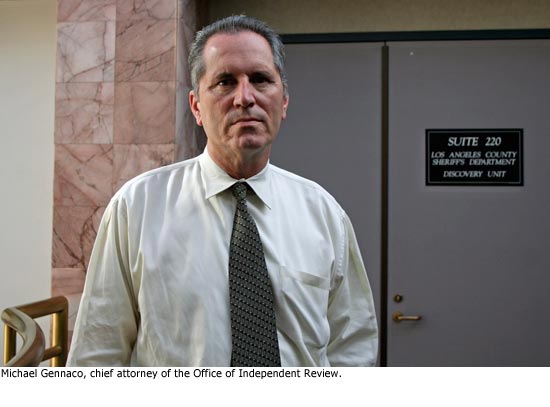

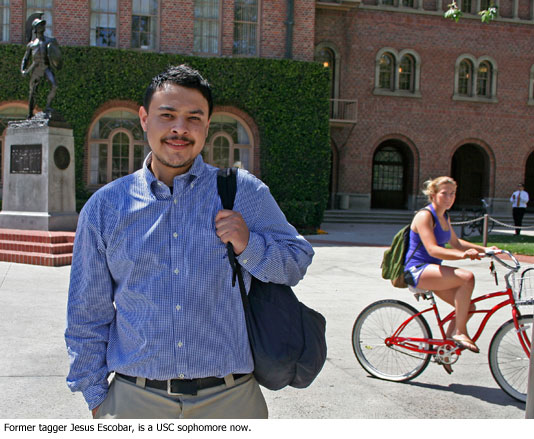

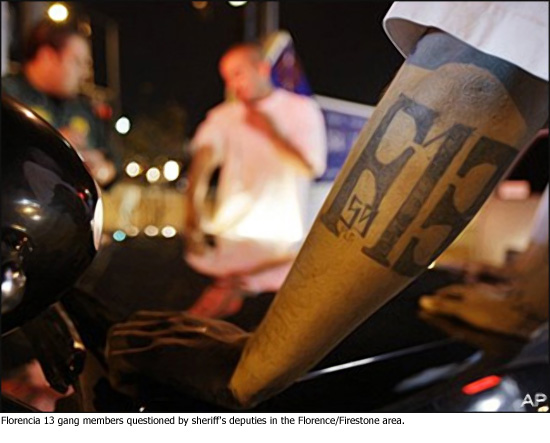








 405 bridge work causes a stink
405 bridge work causes a stink
